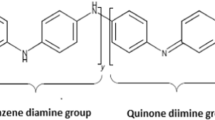Abstract
A new method of making conductive composite films by permeation of the conducting guest species into the host is reported. A layer of poly(3-n-dodecyl thiophene) (P3ddt) is embedded at the surface of polyimide by permeation of the monomer or polymer (in solution in tetrahydrofuran or chloroform) into a solution of polyamic acid in n-methyl pyrrolidinone or dimethyl acetamide. The resulting composites were imidised and polymerized (if necessary). Chemical imidisation yielded composite -films that retained the conducting polymer even when the composite was subjected to solvent extraction. The films were conductive upon doping with iodine and recovered conductivity when they were exposed to iodine vapor subsequent to thermal de-doping. Thermogravimetry showed that the amount of thiophene incorporated into the polyimide was higher for permeation of the polymer than that of the monomer; however, the amount of p3ddt incorporated by the latter method was still higher than the amount that could be incorporated by blending polyamic acid with p3ddt. The levels of conductivity and speed of recovery for doped films were also higher for the permeated films. Results of scanning electron microscopy suggested that the higher mobility afforded by contact in the liquid state have contributed greater entanglement between the constituents leading to higher thermal and solvent resistance of the conducting constituent. The permeation method could be adopted to form composite films in solvent systems that are not completely miscible.
Similar content being viewed by others
References
R. Sugimoto, S Takeda., H. B. Gu, and K. Yoshino, Chem. Express 11, 635–638 (1986).
S. Hotta, S. D. D. V. Rughooputh, and A. J. Heeger, Synth. Met. 22, 79–87 (1987).
E. Ruckenstein, and J. S. Park, J. Appl. Polym. Sci. 42, 925 (1991).
J. E. Osterholm, J. Laakso, and P. Nyholm, Synth. Met. 28, C435–C444 (1989).
K. S. Ho, K. Levon, J. Mao, and W. Y. Zheng, Synth. Met. 55-57, 3591–3596 (1993).
L. H. Dao, X. F. Zhong, A. Menikh, R. Paynter and F, Martim, Annu. Tech. Conf. Soc., Plast. Eng. 49, 783 (1991).
B. Tieke, and W. Gabriel, Polymer 31, 20 (1990).
M. B. Meador, D. H. Green, J. V. Auping, J. R. Gaier, L. A. Ferrara, D. S. Paradopoulos, J. W. Smith, D. J. Keller, J. Appl. Polym. Sci. 63, 7, 821–834 (1997).
Y. Sun, E. Ruckenstein, Synth. Met., 74, 145–150 (1995).
C. E. Sroog; A. L. Engrey; S. V. Abramo; C. E. Berr; W. M. Edwards; and K. L. Olivier, Journal of Polymer Science: Part A, 3, 1373–1390 (1965).
E. Sugimoto, S. Takeda, H. B. Gu, K. Yoshino, Chem. Express 1, 11, 635–638 (1986).
A. L. Endrey, U. S. Patent 3, 179,633, 5pp (1965).
J. W. Wang, M. P. Srinivasan, Synthetic Metals 105, 1–7 (1999).
S. A. Chen, and J. M. Ni, Polymer Bulletin 26, 673–680 (1991).
Author information
Authors and Affiliations
Rights and permissions
About this article
Cite this article
Wang, J.W., Srinivasan, M.P. A conductive composite film by permeation method. MRS Online Proceedings Library 600, 209–214 (1999). https://doi.org/10.1557/PROC-600-209
Published:
Issue Date:
DOI: https://doi.org/10.1557/PROC-600-209




